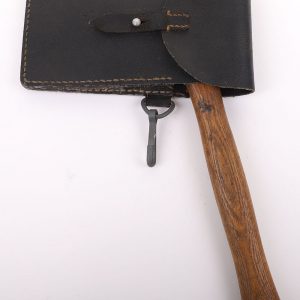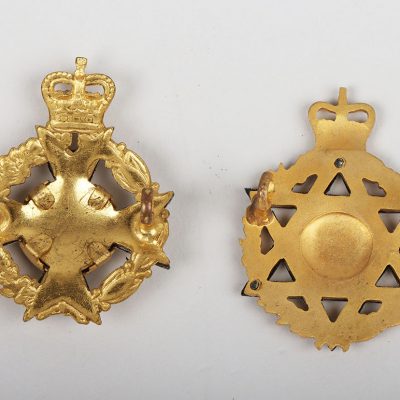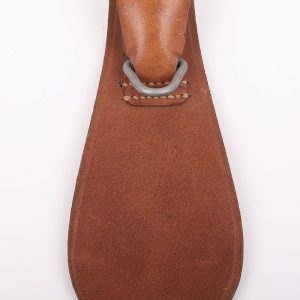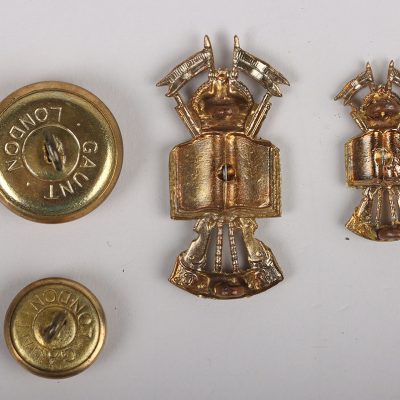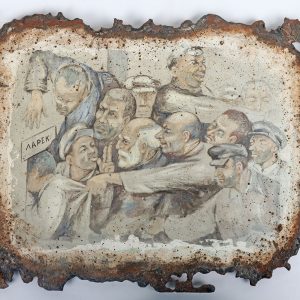Цены, указанные на сайте, могут быть изменены.
Для уточнения актуальных цен свяжитесь с нами или воспользуйтесь формой обратной связи.
Отображение 849–864 из 3607
Фильтры-
#122 – German Kriegsmarine Imperial Conversion Naval Officers Dress Dagger (Лот: 7311)
Ставки принимаются через менеджераGerman Kriegsmarine Imperial Conversion Naval Officers Dress Dagger, interesting example with celluloid covered wooden grip, eagle head pommel and unusual cross guard with a silvered Imperial crown to the centre. Housed in a standard naval officers gilt brass scabbard with two hanging rings. Imperial style rounded edge blade without a makers trademark. The blade measures 25 ¾ cms, overall 42 ½ cms. The dagger grip has some damage and evidence of repair. This dagger is similar to those seen and described as examples for drivers and also airship officers from the Imperial and Weimar republic period.
-
#122 – EIIR Royal Army Chaplain Department (Jewish) Cap Badge (Лот: 10188)
Ставки принимаются через менеджераEIIR Royal Army Chaplain Department (Jewish) Cap Badge, fine silver gilt and enamel cap badge with two lug fittings to the reverse. Accompanied by a EIIR Christian chaplains silver gilt an enamel cap badge with lug fittings. Both remain in excellent overall condition (2 items)
-
#122 – Second World War Arctic Convoys Distinguished Service Cross Medal Group of Eight to Commander P.G Satow Who Survived the Loss of H.M.S. Wild Swan in June 1942 and was Also Twice Mentioned in Despatches Including for the V.C. Action in the Battle of the Barents Sea Where the Destroyers H.M.S. Orwell and H.M.S. Onslow Repelled the Mighty German Cruiser Admiral Hipper, (Лот: 8714)
Ставки принимаются через менеджераSecond World War Arctic Convoys Distinguished Service Cross Medal Group of Eight to Commander P.G Satow Who Survived the Loss of H.M.S. Wild Swan in June 1942 and was Also Twice Mentioned in Despatches Including for the V.C. Action in the Battle of the Barents Sea Where the Destroyers H.M.S. Orwell and H.M.S. Onslow Repelled the Mighty German Cruiser Admiral Hipper, Distinguished Service Cross, GVI, 1st type, reverse officially dated ‘1944’ and additionally engraved ‘PATRICK G. SATOW , ROYAL NAVY’, 1939-45 Star medal, Atlantic Star medal, Africa Star medal, Burma Star medal, War Medal 1939-45 with Mention in Despatches oakleaf, Korea medal, ‘LT. CDR. P.G. SATOW D.S.C. R.N.’ Group mounted for display.istinguished Service Cross, London Gazette 1st January 1944 – The KING has been graciously pleased to approve the following awards for gallantry or outstanding service in the face of the Enemy, or for zeal, patience and cheerfulness in dangerous waters and for setting an example of wholehearted devotion to duty, upholding the high traditions of the Royal Navy – Lieutenant Patrick Graham Satow, Royal Navy (Kettering).ention in Despatches, London Gazette 18th May 1943 – For courage and endurance in action in Northern Waters – Lieutenant Patrick Graham Satow, Royal Navy. Mention in Despatches, London Gazette 11th June 1946 – The KING has been graciously pleased to approve the following awards for distinguished service during the War in the Far East – Lieutenant Patrick Graham SATOW, D.S.C., Royal Navy.atrick Graham Satow joined the Navy as a Cadet in May 1937. On 19th December 1939 he joined HMS Wild Swan as Sub Lieutenant (Navigating Officer), he served onboard until her loss in June 1942 and is often mentioned at length in Peter C. Smith’s history of the ship. Employed on 10 May 1940 to take demolition parties to the Hook of Holland, Wild Swan remained there until the 13th, when she returned to Dover. During that time she engaged enemy batteries, parachute troops and carrier borne troops landing on the beaches, and sustained damage from a near miss which reduced her speed to 15 knots, and necessitated her return to dock for repairs. But she was quickly back at sea, and from the 21st to 25th was employed in escorting ships and evacuating refugees and troops at Dunkirk, Calais and Boulogne. At the latter port she assisted on the 23 May in the final evacuation in the face of heavy air attack and fire from shore batteries, one of her own guns destroying an enemy tank which was ‘roaring down a side street towards the quay’. Gunnery skills aside, Wild Swan’s survival was also down to the navigation of Satow, Signalman W. K. Harrison recalling in Peter C. Smith’s ship history:One man who gained the respect of the people on our bridge was Sub. Lieutenant Satow, our Navigation Officer. On the backward and forward runs, bringing shiploads of soldiers back, we always seemed to pass close to a particular floating mine. On the way out it would be to starboard and on the way back it would be on the port side. We did not worry during the daylight hours as the lookouts would always spot it in good time, but at night there was some concern that they would not see it and would fail to warn us in time to prevent us hitting it. We always seemed to pass four or five feet from it. The Captain would be sitting on his stool on the bridge in front of the binnacle with his duffle-coat on and he would say, ‘Satow, we are coming up near that damned mine, are we not?’ And Satow would reply, ‘It’s all right, sir.’ Sure enough the lookouts would shout out, ‘mine on the port bow’, and we would watch it glide by at the usual distance. Why we never gave it a wider berth I’ll never know. Satow was, however, recognised as a very excellent navigator, even though the mine at night always gave the people on the bridge many secret worries.’ Another witness to Satow’s exceptional qualities as Navigating Officer, as Wild Swan subsequently embarked upon convoy escort work, was Surgeon Lieutenant F. H. D. Hutter: ‘I also met Pat Satow, in those days a Sub. Lieutenant. He was the navigator. In the worst weather imaginable, no sun and no star sights possible, he always seemed spot-on. To me it seemed absolute magic. He was always cheerful and the ship’s tensions seemed to bounce off him. Of all the ship’s officers, I can see him now cheering the wardroom up simply by his presence’.n 17th June 1942 Wild Swan was supporting Convoy HG84 when she was attacked by Ju.88’s. In a ferocious battle she accounted for 6 enemy aircraft but was severely damaged herself and eventually sunk. Satow’s account of the battle is captured in Smith’s book: ‘Within a minute or two, of course, we were at full action stations and then the twelve Huns slowly dropped out from the cloud base. As they crossed ahead of us we opened up with our two foremost 4.7s. The first few rounds burst remarkably close, and at least two of the raiders appeared to be hit, and climbed back into the clouds. A minute or two later these two dropped out of the clouds again steering wildly. We held our breath as they collided head-on, each doing about 300 m.p.h. One caught fire and dived vertically on to a Spanish trawler. The whole lot blew up and a shower of pieces went flying through the air. The other dived headlong into the sea, quite close to the burning wreckage of his opposite number. He released his bombs about a hundred feet up – too late – they fell only a few yards away, and he was also blown to pieces. During the early part of this fierce engagement, Wild Swan was steaming at nearly 25 knots, and altering course continuously to try and avoid the bombs which were falling alarmingly close. She had no time to go and look for German airmen in the sea who might have escaped.’About this time Wild Swan experienced a very near miss which severely shook her entire hull and caused extensive damage. As she lost speed, the rudder also jammed and the crippled destroyer was out of control. Her speed through the water had dropped to only walking pace, when the Wild Swan collided with a trawler which became impaled on her bows. The ship soon stopped, and the Spanish crew were hauled aboard.’The sixth bomber caught us. He dived down out of the sun at an angle of 50 degrees and, although the starboard pom-pom and Lewis gunner fired through his wings, five bombs hit the water 15 feet from the ship’s side and went off immediately under the keel. All the guns were firing individually as the electrical circuits and supplies were shattered. This quarter of an hour gave us time to rig a jury wireless aerial. One aircraft came in and machine-gunned us. Unfortunately for him the 12-pounder crew – by now all stripped to the waist – scored a direct hit on one of the engines. As he turned away, the forward guns engaged him and he slowly lost height, hitting the water in a sheet of spray. Before the aerial was finished somebody yelled, ‘Look out, here he comes.’ High up above a machine was coming down at full throttle. He was about 2000 feet up and had a long way to go. All the guns’ crews spotted him simultaneously and I don’t think I’ve ever seen so much stuff going up into one machine. He turned his cannon on us and let go four 500lb. bombs. They fell a few feet from our starboard quarter. Although the Lewis and Bren gunners could see this lot coming straight for us, they kept up a hail of fire right till the bombs exploded. There was a rending of steel plates as the old ship broke her back. The flooding of the engine room was completed, depth charges thrown into the air and the 12-pounder lifted clean off its mounting.’ith the order to ‘Abandon ship’ given, Wild Swan’s survivors took to the water, some reaching Carley floats, others the ship’s whaler and motorboat, and a Merchant Navy pattern raft which had been recovered at sea at an earlier date. A long night ensued, during which Satow recalled ‘thoughts were mainly centred on the chances of being found the next day’ – and 30 men died of exposure. Salvation finally arrived in the form of the destroyer Vansittart, which was directed to the survivors by an R.A.F. Sunderland.is next appointment was to the destroyer HMS Orwell, on board which he saw many Arctic convoys none though as eventful as convoy JW 51Bin early 1944 which developed into the Battle of the Barents. This action is covered extensively in Dudley Pope’s book, 73 North. Orwell was one of 6 destroyers escorting the convoy when it was attacked by the pocket battleship ‘Lutzow’ and the heavy cruiser ‘Hipper’ with their destroyer escorts. Orwell played a prominent part alongside the flotilla leader H.M.S. Onslow, in driving off the attacks by Hipper during which Captain Sherbrooke D.S.O. of Onslow was awarded the Victoria Cross.It was an unequal contest and, since the Hipper’s gunners would soon get the Onslow’s range, it could surely have only one outcome. The Hipper’s eight 8-inch guns fired a broadside weighing more than 2000 lb., and the six 4.1-inch anti-aircraft guns added another 200 lb. In reply the Onslow’s two guns (two were still frozen up) fired a 96 lb. reply and the Orwell’s four 4-inch guns a 124 lb. broadside. A total of more than 2200 lb. versus 220 lb. Thus the Hipper had the advantage of being able to fire nearly a ton more of high explosives and in addition she knew the guns of the Onslow and Orwell could do her little harm … ‘ What followed led to the award of the Victoria Cross to Sherbrooke of the Onslow, for it was to his command that the Hipper first turned her attention, again and again ominous red glows rippling along the enemy cruiser’s side as she fired her 8-inch guns – several found their mark, turning the little destroyer into a mass of flames forward, but Sherbrooke remained very much in command on the bridge, despite being grievously wounded by a shell splinter – his left eye was hanging down his face. 73 North continues: ‘From astern Austen, in the Orwell, had seen the salvos falling near the Onslow; then the flash of a hit on the funnel was followed by the two hits forward and the whole ship dissolved into a cloud of smoke and steam which streamed aft from a pulsating nucleus of fire. He thought she was going to blow up and immediately came round to port to keep clear. A few moments later he saw her alter away to starboard. Immediately the Hipper’s gunners switched target and her 8-inch salvos started falling with deadly monotony round the Orwell. Austen ordered her to make smoke to help screen the Onslow. At the same time he had only a few seconds in which to decide the next move. With the Onslow out of action he was now the Hipper’s main target, and the only ship effectively placed to fight her off from the convoy. Should he try to make a solo torpedo attack on her – an attack probably doomed to fail because of the Hipper’s tremendous gun power, and which would almost certainly mean the destruction of his ship? Or would it be better to turn away and cover the stricken Onslow? That would leave the Hipper open to come down to the convoy. It was an awful decision to have to make, and could mean the sentence of death for his whole crew. Then as he watched, he saw the Hipper’s dim silhouette changing and at the same time the shells stop falling round: the Germans themselves had saved him making the decision, for the Hipper was turning away, retiring to the east into the dark anonymity of a convenient snow squall. Thankfully Austen turned the Orwell back to cover the burning ship.’atow then transferred to the destroyer Myngs in early 1944 and in July of the same year he moved to another destroyer, H.M.S. Kempenfeldt serving in Pacific region. In February 1949 he was promoted to Lieutenant-Commander and served as a navigation specialist int aircraft carrier H.M.S. Glory during the Korea war. He later served with N.A.T.O. and retired as a Commander in 1957.x R.C. Witte collection.
-
#123 – Rare Soviet Russian Porcelain Propaganda Plate by Rudolf Feodorovich Vilde (Лот: 5120)
Ставки принимаются через менеджераRare Soviet Russian Porcelain Propaganda Plate by Rudolf Feodorovich Vilde, plate depicting a Bolshevik worker heroically coming to rescue the Volga region’s populace from starvation, personified as the Grim Reaper carrying off a bundle of wheat. Gilt decoration around the edge of the plate. Generally good condition. As a result of the First World War and the Russian Civil Wars which followed, the production of grain fell drastically, leading to widespread food shortages. The famine, which killed an estimated 6 million Russians, was most devastating in the Volga and Ural regions. In 1921, Lenin initiated reforms to food distribution and consumption under the New Economic Policy in an effort to curtail the devastating effects of the famine. Vilde and his comrades at the State Porcelain Factory painted ceramics to raise funds to aid in the relief effort.Vilde’s career began in 1905 as a ceramics painter at the Imperial Porcelain Factory where a year later he became head of the workshop. In this position until 1930, Vilde was part of the factory’s revolutionary transformation from producing wares exclusively for the Tzar and his court to repurposing the many imperial blanks for propagandistic ends as part of the new mandate for the State Porcelain Factory, rechristened after the Russian Revolution of 1917. Under the leadership of Sergi Chekhonin, artistic director from 1918–1923, a nationalistic yet stylistically diverse visual program was incorporated into the decoration of simple utilitarian objects, such as plates, bowls, and small tea sets. The wares ranged in style from the avant-garde abstraction of Kazimir Malevich’s Suprematism, to the folk-derived social realism of Vilde’s example here. It was this later style that eventually triumphed as the prevailing Stalinist aesthetic.
-
#123 – WW2 German Kriegsmarine Officers Dress Dagger Attributed to Wilhem Böttcher, Believed to have Served on German U-Boats (Лот: 7312)
Ставки принимаются через менеджераWW2 German Kriegsmarine Officers Dress Dagger Attributed to Wilhem Böttcher, Believed to have Served on German U-Boats, good example of an Imperial conversion piece, having Third Reich eagle pommel top, white celluloid grips with the wire binding and brass cross guard with press stud release button. Attached to the grip is a fine golden wire officers dress portepee / knot. Housed in a polished hammered scabbard with the two hanging rings being pushed into rectangles. Polished plain Imperial type dirk blade with the owners name engraved to the forte ‘Wilhem Böttcher’. Blade 21cms, overall 42cms. Some cracks to the celluloid grip, exterior shows some wear. Vendors family state that the dagger was sold as belonging to an officer who served in the U-Boat service, however we can not find any evidence of this.
-
#123 – Rare Trial Pattern Royal Army Education Corps Cap Badge (Лот: 10189)
Ставки принимаются через менеджераRare Trial Pattern Royal Army Education Corps Cap Badge, fine example in bi-metal, two lug fittings to the reverse. Accompanied by matching collar badge an two tunic buttons. All by J R Gaunt, purchase from the pattern books directly from J R Gaunt by the current vendor. (4 items)
Лидирует ставка 80 £ -
#123 – WW2 1945 Bomber Command Distinguished Flying Medal Group of 5 to a Mid-Upper Gunner in a 12 Squadron Lancaster Bomber, Who Flew at least 29 Operational Sorties and was Credited with Destroying 1 Enemy Aircraft and Damaging at least 1 Other (Лот: 8715)
Ставки принимаются через менеджераWW2 1945 Bomber Command Distinguished Flying Medal Group of 5 to a Mid-Upper Gunner in a 12 Squadron Lancaster Bomber, Who Flew at least 29 Operational Sorties and was Credited with Destroying 1 Enemy Aircraft and Damaging at least 1 Other, Distinguished Flying medal, GVIR 1st type, officially engraved naming, ‘2219060 F/SGT. A.J. BATE R.A.F.’, 1939-45 Star medal, France & Germany Star medal, Defence medal and War medal 1939 – 45, the last 4 all privately engraved ‘F/SGT A J BATE DFM, 12 SQDN, 1 GP, BMR CMMD’. Group display mounted.ondon Gazette, 17th July 1945, The KING has been graciously pleased to approve the following awards: — Distinguished Flying Medal, 2219060 Arthur James BATE, R.A.F.V.R., 12 Sqnecommendation – Flight Sergeant Bate is the mid-upper gunner of a Lancaster bomber and has flown 29 successful sorties against the enemy. Many of these attacks have been against deep penetration targets such as Munich, Nuremberg, Dresden and Chemnitz. This gunner’s air discipline has at all times been beyond reproach and his coolness and fighting spirit has inspired the highest standard of morale in his crew. On the night of the 2/3 January 1945, while returning from an attack on Nuremberg, our aircraft was illuminated by fighter flares and a Ju.88 was sighted by Flight Sergeant Bate attacking in the starboard quarter down. Flight Sergeant Bate immediately requested the correct evasive action to be taken and accurate fire, obtained numerous strikes on the enemy fighter which was last seen diving steeply away to starboard. Previously on the same night, this N.C.O. was concerned in a successful combat with an Me.109 when he materially assisted his rear gunner with the destruction of this aircraft. On several other occasions, Flight Sergeant Bate has, by his aggressive spirit, assisted in driving off impeding attacks by enemy fighters. The courage and skill of this N.C.O. is of the highest order and I have no hesitation in recommending him for the award of the Distinguished Flying Medal.emarks by Station Commander: Flight Sergeant Bate, as mid-upper gunner, has displayed a magnificent fighting spirit in action. His immediate recognition of danger, his superb handling of his guns and his good directions to his captain in combat have inspired his crew with the utmost confidence and made him an indispensable member. I strongly recommend that the fine fighting spirit and proved ability shown by this N.C.O. be rewarded by the award of the Distinguished Flying Medal.’rthur James Bate flew his operational service as an Air Gunner in Lancaster bombers with 12 Squadron flying at least 29 sorties between September 1944 and March 1945 his targets including: Frankfurt, Calais (2), Neuss, West Kappelle Seawall, Wilhelmshaven, Stuttgart, Essen, Bonn (2), Cologne (3), Dusseldorf, Gelsenkirchen, Wanne Eickel, Schaffenburg, Dortmund (2), Nuremberg (2), Royan, Munich, Vattegort, Cleve, Dresden, Chemnitz, Duisberg, Pforzheim, Mannheim and Misburg.
-
#124 – GERMAN WWII k-98 COMBAT BAYONET (Лот: 5455)
Ставки принимаются через менеджераGERMAN WWII k-98 COMBAT BAYONET, matching example, ricasso is mkd. ‘CARL EICKHORN’ on 1 side on the other is ‘8240 S’, the blade bluing is very nice but has been thinly sharpened which looks ok, the spine of the blade is marked ’38’, complete w/ a nice black leather frog maker mkd. & dated 1941, scabbard has a few areas of lite rust, overall low exc.
-
#124 – Rare WW2 German Deluxe Pattern Kriegsmarine Officers Dress Dagger by WKC (Лот: 7313)
Ставки принимаются через менеджераRare WW2 German Deluxe Pattern Kriegsmarine Officers Dress Dagger by WKC, superb example of the very rare deluxe model naval officers dagger with deep orange celluloid grip with the original wire binding. Gilt metal eagle pommel top and cross guard. Complete with its original dress portepee / knot in light golden wire with silver fleck. Dagger is complete with the deluxe hand chassed and hammered scabbard. Fine condition double edged blade with the standard etched decoration and makers trademark to the base. The blade measures 25cms, overall 40 ¾ cms. These deluxe pattern scabbards were special order by the particular naval officer from WKC and you can find various types of these, see ‘Exploring the Dress Daggers of the German Navy’ by Thomas T Wittmann pages 371-376 for more information about these specially produced / purchased daggers.
